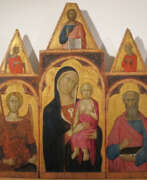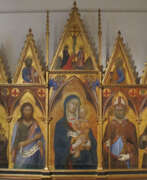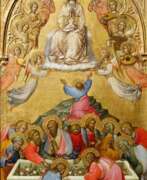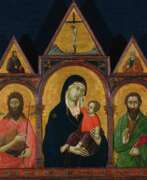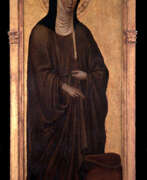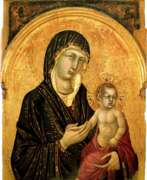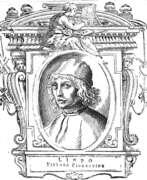Icon painters 14th century


Bartolomeo Bulgarini (also Bartolomeo Bolgarini) was an Italian painter of the Sienese School. Before he could be identified by name and his work classified, some of his paintings were grouped in art history under the pseudonyms Ugolino Lorenzetti or Master of Ovile.


Niccolò di Pietro Gerini was a pivotal figure in the Italian art scene of the late Gothic period, celebrated for his contributions that spanned from the late 14th to the early 15th century. Born in Florence around 1340, Gerini's artistry flourished within the walls of his native city, although his talent also led him to work in Pisa and Prato. Unlike the innovative currents that swept through the art world during his time, Gerini remained faithful to traditional compositions, favoring stiff and dramatic movements in his figures.
Gerini's education and career were deeply intertwined with the artistic guilds of Florence. His father's membership in the Guild of Saint Luke in 1339 paved the way for Gerini's own entry into the Arte dei Medici e Speziali Guild by 1368, a testament to his early involvement in the city's artistic fabric. His works, marked by their large chins, sloping foreheads, and sharp noses, bore the influence of Gothic depictions, aligning him with the schools of Giotto di Bondone, Andrea di Orcagna, and Taddeo Gaddi.
Throughout his career, Gerini collaborated with notable artists like Jacopo di Cione, contributing to frescoes for the Guild hall of the Judges and Notaries in Florence and working on significant projects such as the altarpiece for the Coronation of the Virgin at San Pier Maggiore, Florence. His ability to blend architectural design with his painting skill is evident in these collaborations.
Gerini's paintings, including the triptych from 1387 housed in the National Gallery, London, and the Crucifixion, showcase his mastery over egg tempera on wood, a medium through which he conveyed religious narratives with profound solemnity and intricate detail. His works are preserved in prestigious collections, including The Hermitage, St. Petersburg, and the Alte Pinakothek, Munich, reflecting his enduring legacy in the annals of art history.
For collectors and experts in art and antiques, Gerini's oeuvre offers a rich exploration of late Gothic artistry, characterized by its adherence to traditional values while simultaneously capturing the spiritual and cultural nuances of his time. To stay informed on new discoveries and auction events related to Niccolò di Pietro Gerini, signing up for updates is a valuable resource for enthusiasts keen on this remarkable period of art history.


Ambrogio Lorenzetti or Ambruogio Laurati was an Italian painter of the Sienese school. He was active from approximately 1317 to 1348. He painted The Allegory of Good and Bad Government in the Sala dei Nove (Salon of Nine or Council Room) in Siena's Palazzo Pubblico. His elder brother was the painter Pietro Lorenzetti.


Pietro Lorenzetti was an Italian painter whose innovative contributions to the Sienese school of art marked a significant departure from the Byzantine style of the medieval period. Born in Siena, Lorenzetti was known for his detailed and expressive approach to painting, which helped lay the groundwork for the Italian Renaissance.
Renowned for his mastery in depicting light, shadow, and space, Lorenzetti introduced a sense of depth and realism previously unseen in Italian art. His works are characterized by a rich color palette and a keen observation of the human condition, rendering scenes with emotional depth and a tangible sense of atmosphere.
Among his most celebrated works is the "Birth of the Virgin" fresco in the Siena Cathedral, a masterpiece that showcases his ability to weave narrative and decoration into a cohesive whole. Lorenzetti's religious paintings, which are housed in various museums and churches, remain pivotal in understanding the evolution of European art during the 14th century.
For collectors and experts in art and antiques, Pietro Lorenzetti represents a fascinating study in the transition from medieval to Renaissance art. His contributions not only enriched the Italian artistic heritage but also influenced generations of artists to come.
To explore the legacy of Pietro Lorenzetti and stay informed about the latest research, exhibitions, and auction events featuring his work, signing up for updates is essential. This subscription will ensure that aficionados and collectors alike are always connected to the vibrant world of Sienese painting, offering exclusive insights and opportunities to appreciate the art of this pioneering master.


Master Badia a Isola (Italian: Maestro di Badia a Isola) was an Italian anonymous painter of the Sienese school who worked in and around Siena in the late 13th and early 14th centuries.
The conditional name of the master comes from the large icon "Madonna on the throne with a child and two angels" (Maesta), which used to be in the church of St Salvatore and Sirin in Badia a Isola in Monteriggioni.
Researchers believe that the Master of Badia a Isola belonged to the inner circle of the great Duccio di Buoninsegna, and was in the first rank of his pupils and followers. It is assumed that he worked in the workshop in the early period of Duccio's work. His works have direct parallels with those of Ugolino di Nerio, especially in the delicate contours of the figures and the sweet faces of the Madonnas.


Paolo Veneziano was a 14th-century painter from Venice, the "founder of the Venetian School" of painting, probably active between about 1321 and 1362.
He led the development in Venice of the elaborately-framed polyptych or "composite altarpiece" form, which became popular all over Italy during the 13th century, partly in response to liturgical changes (only reversed in the 20th century) which placed the priest celebrating mass on the same side of the altar as the congregation, so with his back to them for much of the time. This encouraged the creation of altarpieces behind and above the altar, as a visual devotional focus. He is the oldest Venetian painter whose name is known, and the earliest to paint the new subject of the Coronation of the Virgin.


